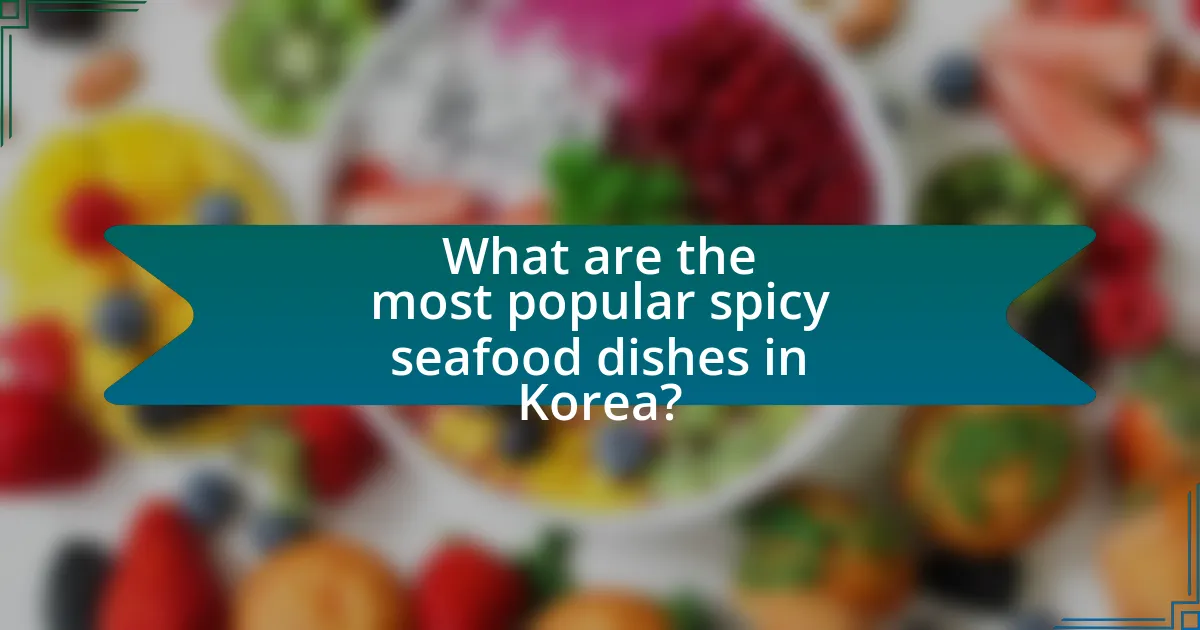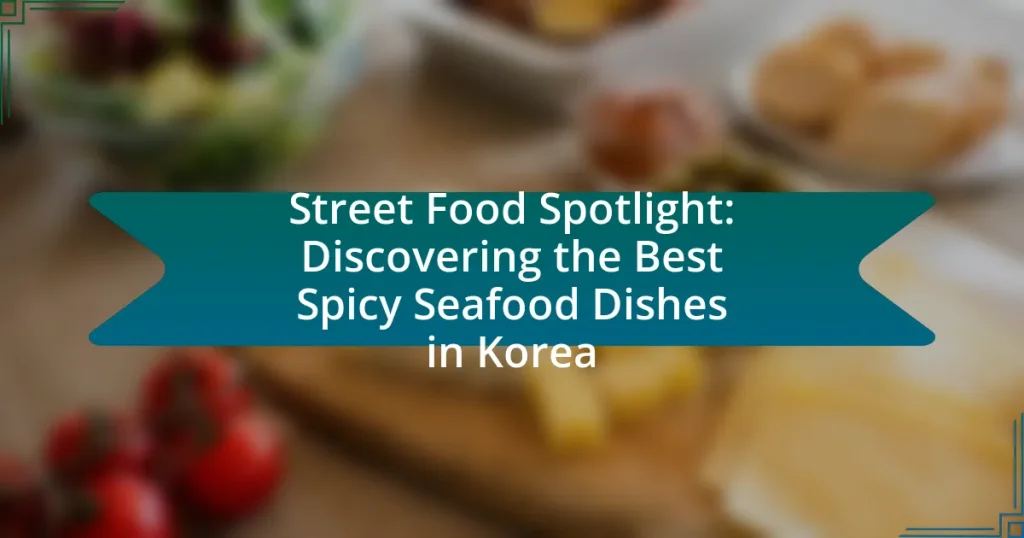The article focuses on the vibrant street food culture in Korea, specifically highlighting the most popular spicy seafood dishes such as spicy seafood stew (jjigae), spicy grilled squid (ojingeo gui), and spicy stir-fried octopus (nakji bokkeum). It explores how these dishes reflect Korean culinary traditions through bold flavors, communal dining, and the use of fresh, local ingredients. The article also examines regional variations in preparation, the significance of street food markets like Jagalchi and Gwangjang, and the health benefits associated with consuming spicy seafood. Additionally, it provides insights into the preparation methods used by street vendors and offers tips for enhancing the experience of enjoying these dishes in Korea.

What are the most popular spicy seafood dishes in Korea?
The most popular spicy seafood dishes in Korea include spicy seafood stew (jjigae), spicy grilled squid (ojingeo gui), and spicy stir-fried octopus (nakji bokkeum). Spicy seafood stew, often made with a variety of seafood and gochugaru (Korean red pepper flakes), is a staple in Korean cuisine, known for its rich flavor and heat. Spicy grilled squid is typically marinated in a spicy sauce and grilled, making it a favorite street food item. Spicy stir-fried octopus combines octopus with vegetables and a spicy sauce, offering a bold taste that is well-loved. These dishes reflect Korea’s culinary emphasis on bold flavors and seafood.
How do these dishes reflect Korean culinary traditions?
These dishes reflect Korean culinary traditions through their emphasis on bold flavors, communal dining, and the use of fresh, local ingredients. Korean cuisine is characterized by its balance of spicy, sweet, and savory elements, often achieved through the use of gochujang (red chili paste) and garlic, which are prevalent in spicy seafood dishes. Additionally, the tradition of sharing food among diners highlights the cultural importance of community and togetherness in Korean meals. The reliance on seasonal seafood showcases Korea’s coastal geography and the significance of seafood in the national diet, reinforcing the connection between the land and the culinary practices.
What ingredients are commonly used in these spicy seafood dishes?
Common ingredients in spicy seafood dishes include gochugaru (Korean red pepper flakes), garlic, ginger, soy sauce, sesame oil, and various types of seafood such as shrimp, squid, and clams. Gochugaru provides the signature heat and flavor, while garlic and ginger enhance the overall taste profile. Soy sauce adds umami, and sesame oil contributes a nutty aroma. These ingredients are foundational in many Korean spicy seafood recipes, reflecting traditional culinary practices.
How do regional variations influence the preparation of these dishes?
Regional variations significantly influence the preparation of spicy seafood dishes in Korea by incorporating local ingredients, cooking techniques, and flavor profiles. For instance, coastal regions like Busan utilize fresh seafood such as squid and clams, often prepared in spicy stews or grilled, reflecting the availability of local catch. In contrast, inland areas may adapt these dishes by using preserved seafood or different spices, resulting in unique interpretations. Additionally, regional festivals and cultural practices shape the recipes, as seen in Jeolla Province, where the use of gochujang (red chili paste) is prevalent, enhancing the spiciness and depth of flavor in their seafood dishes. This diversity showcases how geography and culture directly impact culinary practices in Korean street food.
Why is street food culture significant in Korea?
Street food culture is significant in Korea because it reflects the country’s culinary diversity and social dynamics. This culture allows for the accessibility of traditional dishes, such as tteokbokki and hotteok, to a wide range of people, fostering community interaction and cultural exchange. Additionally, street food markets, like Gwangjang Market, serve as vibrant hubs where locals and tourists alike experience authentic flavors and cooking techniques, contributing to Korea’s identity and tourism. The popularity of street food is evidenced by the increasing number of food stalls, which have grown from around 10,000 in 2010 to over 30,000 in 2020, highlighting its integral role in daily life and the economy.
What role does spicy seafood play in the street food scene?
Spicy seafood plays a crucial role in the street food scene by offering bold flavors and cultural significance. In Korea, dishes like spicy squid and fish cakes are not only popular for their heat but also reflect the country’s culinary heritage, attracting locals and tourists alike. The vibrant street food markets, such as those in Busan, showcase these spicy seafood options, contributing to the overall experience and identity of Korean street food culture.
How do street vendors prepare and serve these dishes?
Street vendors prepare and serve spicy seafood dishes by utilizing fresh ingredients and traditional cooking methods. They typically source seafood daily from local markets to ensure quality and freshness. Common preparation techniques include grilling, frying, or boiling, often accompanied by spicy sauces or marinades that enhance flavor. Vendors serve these dishes in portable containers, allowing customers to enjoy them on the go, often garnished with vegetables or herbs for added taste and presentation. This approach not only emphasizes the authenticity of the cuisine but also caters to the fast-paced lifestyle of street food consumers in Korea.

Where can you find the best spicy seafood street food in Korea?
The best spicy seafood street food in Korea can be found in the bustling markets of Busan, particularly at Jagalchi Fish Market. This market is renowned for its fresh seafood offerings, including spicy dishes like spicy stir-fried octopus (nakji-bokkeum) and spicy seafood soup (jjampong). Jagalchi Fish Market is the largest seafood market in Korea, attracting both locals and tourists, and it showcases a variety of seafood prepared with bold spices, making it a prime destination for spicy seafood street food enthusiasts.
What are the top street food markets known for spicy seafood?
The top street food markets known for spicy seafood in Korea include Gwangjang Market, Noryangjin Fish Market, and Jagalchi Fish Market. Gwangjang Market is famous for its spicy seafood dishes like spicy octopus and seafood pancakes, attracting both locals and tourists. Noryangjin Fish Market offers a variety of fresh seafood, including spicy seafood stews, and is a popular destination for seafood lovers. Jagalchi Fish Market, located in Busan, is renowned for its diverse selection of spicy seafood options, including raw fish served with spicy sauces. These markets are celebrated for their vibrant atmosphere and authentic culinary experiences.
How do these markets differ in their offerings?
The markets differ in their offerings primarily through the variety and preparation methods of spicy seafood dishes available. For instance, the Noryangjin Fish Market specializes in fresh seafood that can be prepared on-site, allowing customers to choose live fish and have it cooked immediately, which emphasizes freshness. In contrast, the Gwangjang Market focuses on traditional Korean street food, offering dishes like spicy seafood pancakes and stir-fried octopus, which are pre-prepared and served quickly to cater to a fast-paced dining experience. This distinction highlights how each market caters to different consumer preferences, with Noryangjin emphasizing freshness and customization, while Gwangjang prioritizes convenience and traditional flavors.
What are some must-try stalls or vendors in these markets?
Some must-try stalls or vendors in Korean markets for spicy seafood dishes include the Gwangjang Market’s “Bindaetteok” stall, known for its mung bean pancakes served with spicy seafood, and the Noryangjin Fish Market, where “Sashimi” vendors offer fresh seafood with spicy dipping sauces. Additionally, the Jagalchi Fish Market in Busan features various stalls serving “Sannakji,” a dish of live octopus seasoned with sesame oil and chili. These vendors are renowned for their authentic flavors and high-quality ingredients, making them essential stops for anyone exploring Korea’s spicy seafood offerings.
How do locals choose their favorite spicy seafood dishes?
Locals choose their favorite spicy seafood dishes based on personal taste preferences, regional specialties, and the freshness of ingredients. They often rely on recommendations from friends and family, as well as popular food stalls known for their unique flavors and cooking techniques. Additionally, locals may consider the level of spiciness that suits their palate, which can vary widely among different dishes. The popularity of certain dishes can also be influenced by seasonal availability of seafood, ensuring that the freshest options are selected.
What factors influence their preferences?
Culinary preferences for spicy seafood dishes in Korea are influenced by factors such as cultural heritage, regional availability of ingredients, and individual taste profiles. Cultural heritage shapes preferences through traditional recipes and cooking methods that emphasize bold flavors and spice levels, often passed down through generations. Regional availability affects preferences as certain coastal areas may have access to fresher seafood, leading to a greater variety of dishes. Individual taste profiles, including personal tolerance for spice and flavor combinations, also play a significant role in determining what dishes are favored.
How do personal experiences shape their choices?
Personal experiences significantly shape choices by influencing preferences, tastes, and decision-making processes. For instance, an individual who grew up enjoying spicy seafood dishes in Korea may develop a strong preference for similar flavors, leading them to seek out street food that reflects those experiences. Research indicates that food preferences are often formed through early exposure and cultural context, which can dictate what individuals find appealing or unappealing. This connection between personal history and culinary choices illustrates how experiences directly inform and guide food-related decisions.

What are the health benefits and considerations of spicy seafood dishes?
Spicy seafood dishes offer several health benefits, including enhanced metabolism, improved cardiovascular health, and increased antioxidant intake. The capsaicin found in spicy ingredients, such as chili peppers, can boost metabolic rate and promote fat burning, which aids in weight management. Additionally, seafood is rich in omega-3 fatty acids, which are known to support heart health by reducing inflammation and lowering blood pressure. Furthermore, the combination of spices and seafood provides a variety of antioxidants that help combat oxidative stress in the body. However, considerations include potential digestive discomfort for individuals sensitive to spicy foods and the risk of high sodium content in some spicy seafood preparations, which can affect blood pressure.
How do spicy seafood dishes contribute to a balanced diet?
Spicy seafood dishes contribute to a balanced diet by providing essential nutrients, including high-quality protein, omega-3 fatty acids, and vitamins, while also incorporating beneficial spices that can enhance metabolism. Seafood is rich in protein, which is crucial for muscle repair and growth, and omega-3 fatty acids, found in fish like mackerel and salmon, support heart health and cognitive function. Additionally, spices such as chili peppers contain capsaicin, which has been shown to boost metabolism and may aid in weight management. This combination of nutrients and health benefits makes spicy seafood dishes a valuable component of a balanced diet.
What nutritional values do these dishes offer?
Spicy seafood dishes in Korea offer a rich array of nutritional values, including high protein content, essential omega-3 fatty acids, and various vitamins and minerals. For instance, dishes like spicy squid and octopus are excellent sources of protein, providing around 20 grams per 100 grams, which supports muscle health and repair. Additionally, seafood is known for its omega-3 fatty acids, which are beneficial for heart health and cognitive function. Furthermore, these dishes often include vegetables and spices, contributing vitamins A and C, as well as antioxidants that enhance overall health. The combination of these nutrients makes Korean spicy seafood dishes not only flavorful but also nutritionally beneficial.
Are there any health risks associated with consuming spicy seafood?
Consuming spicy seafood can pose health risks, particularly for individuals with certain medical conditions. Spicy foods can exacerbate gastrointestinal issues, such as acid reflux or irritable bowel syndrome, leading to discomfort or pain. Additionally, seafood may carry risks of foodborne illnesses, especially if not properly cooked or stored, which can be heightened by the addition of spicy ingredients that mask spoilage. According to the Centers for Disease Control and Prevention, seafood is a common source of foodborne pathogens, and spicy seasonings do not eliminate these risks.
What tips can enhance your experience of enjoying spicy seafood in Korea?
To enhance your experience of enjoying spicy seafood in Korea, try pairing the dishes with traditional beverages like soju or makgeolli, which can balance the heat. Additionally, opt for local markets or street vendors known for their fresh seafood, as they often provide authentic flavors and preparation methods. Engaging with the vendors can also offer insights into the best dishes and preparation styles, enriching your culinary experience.
How can you best prepare for trying these dishes?
To best prepare for trying spicy seafood dishes in Korea, familiarize yourself with the specific ingredients and flavors commonly used in these dishes, such as gochujang (red chili paste) and various seafood types like octopus and shrimp. Understanding the spice levels and regional variations will enhance your experience, as Korean street food often features unique combinations of heat and umami. Additionally, consider practicing tolerance for spicy foods by gradually increasing your spice intake prior to your culinary adventure, as this can help you enjoy the dishes without discomfort.
What are some common etiquette practices when eating street food in Korea?
Common etiquette practices when eating street food in Korea include using chopsticks or a fork instead of hands, as this shows respect for the food and the vendor. Additionally, it is customary to eat while standing or walking rather than sitting, as street food is often designed for quick consumption. It is also polite to thank the vendor after purchasing food, which acknowledges their service. Furthermore, avoiding loud eating noises is considered respectful in Korean culture. These practices reflect the social norms and values surrounding food consumption in Korea.


